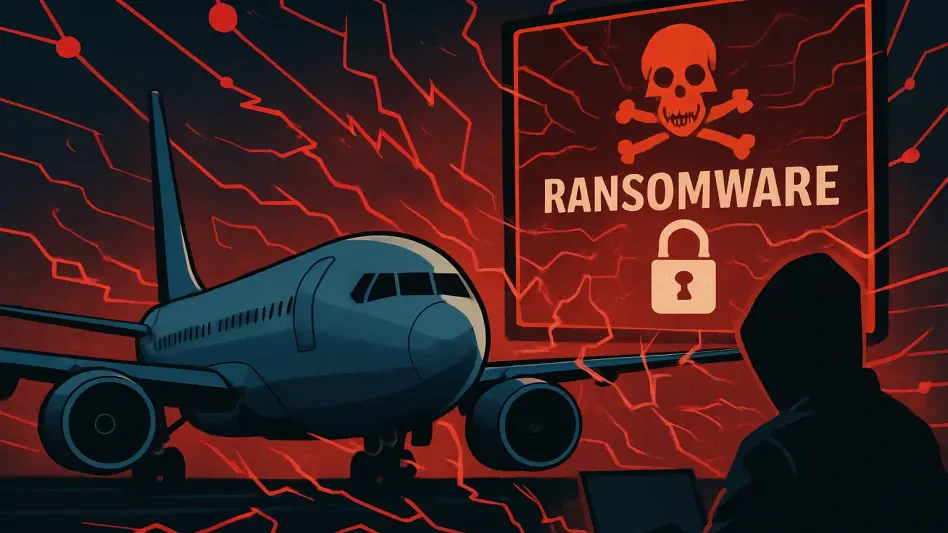What happens when the digital backbone of Europe’s busiest airports collapses under a malicious cyber onslaught? On a seemingly routine Friday, a ransomware attack targeted Collins Aerospace, a titan in aviation technology, disrupting its Multi-User System Environment (MUSE) software, which is critical for check-ins and baggage handling. This system faltered, leaving passengers stranded and flights delayed at major hubs like London Heathrow, Brussels, and Berlin Brandenburg. The fallout caught the attention of the U.K. National Crime Agency (NCA), sparking a high-stakes investigation into a crime that exposed the fragility of modern aviation.
The Stakes of a Grounded Industry
The significance of this incident cannot be overstated. Aviation isn’t just about getting from point A to point B; it’s a cornerstone of global economies and personal connectivity, with millions relying on seamless operations daily. When a system like MUSE fails, the ripple effects touch countless lives—business travelers miss crucial meetings, families are separated, and airlines face staggering financial losses. This attack serves as a stark reminder of how deeply technology is woven into critical infrastructure and why protecting it is a matter of national and international urgency.
Beyond the immediate chaos, this event highlights a growing vulnerability in an industry that handles sensitive data and operates on razor-thin margins. Cybersecurity breaches in aviation are not just inconveniences; they pose risks to safety, trust, and economic stability. With the NCA stepping in to apprehend a suspect, the story underscores a pressing need to address these digital threats before they escalate further.
Aviation Under Siege: A Rising Cyber Threat
The aviation sector has become a prime target for cybercriminals, drawn by the high stakes and interconnected systems that define it. A single breach can disrupt not just one airline, but entire networks of airports and service providers, as seen with the MUSE software outage. This shared platform, used by multiple carriers for passenger processing, became a choke point when ransomware struck, revealing how a localized attack can have widespread consequences.
Statistics paint a grim picture: according to industry reports, cyberattacks on critical infrastructure have surged by over 30% in the last two years alone, from 2023 onward. Aviation, with its reliance on real-time data and complex logistics, offers a lucrative playground for hackers seeking to exploit vulnerabilities. The implications extend beyond delayed flights—such incidents threaten public confidence and could even compromise safety protocols if critical systems are tampered with.
This growing menace demands attention from all stakeholders, from airline executives to government agencies. The Collins Aerospace incident isn’t an isolated case but part of a troubling pattern where digital threats increasingly target sectors that society depends on most. Understanding this context is vital to grasping the urgency of bolstering defenses in an era where cyber warfare knows no borders.
Dissecting the Ransomware Assault on MUSE
Delving into the specifics, the attack unfolded with ruthless efficiency. On that fateful Friday, Collins Aerospace detected the HardBit ransomware infiltrating its MUSE system, a platform integral to managing passenger check-ins and baggage operations. The immediate impact was staggering—flights were delayed or canceled across key European airports, with passengers left in limbo at terminals from London to Berlin.
RTX, the parent company of Collins Aerospace, swiftly activated its incident response protocols, as detailed in a filing with the Securities and Exchange Commission. Collaborating with cybersecurity experts and law enforcement, the company worked to contain the breach and support affected airlines, many of whom resorted to manual processes. Despite these efforts, the damage was done, with airports like Brussels reporting a 6% cancellation rate days after the initial strike, underscoring the difficulty of restoring normalcy in a tightly knit operational ecosystem.
The lingering effects at hubs such as Berlin Brandenburg further illustrate the challenge. Airport spokespersons expressed frustration over uncertain recovery timelines, with backup systems struggling to handle the volume of disrupted services. This cascade of disruptions paints a vivid picture of how a single point of failure in a shared digital infrastructure can grind an entire industry to a halt.
Voices from the Frontline: Experts and Investigators Speak
Insights from those directly involved shed light on the complexity of this cybercrime. Paul Foster, Deputy Director of the NCA’s National Cyber Crime Unit, emphasized the agency’s resolve after arresting a man in his forties in West Sussex under suspicion of violating the Computer Misuse Act. “Cybercrime knows no boundaries, and neither does our commitment to disrupting it,” Foster stated, signaling that the investigation, still in early stages, is a priority for protecting the public.
Adding technical depth, cybersecurity expert Kevin Beaumont dissected the HardBit ransomware, describing it as a deceptively simple yet persistent threat under a Ransomware-as-a-Service model. “What’s unique is how they tailor ransom demands based on a victim’s cyber insurance details,” Beaumont noted, highlighting a calculated approach to maximize payouts. He also cautioned about reinfection risks during recovery, pointing to the need for expert intervention in such cases.
Further context comes from research by CYFIRMA, which suggests potential links to threat groups like Alixsec and Scattered Spider, known for targeting critical sectors. These groups often employ social engineering to breach systems, a tactic that amplifies the danger they pose. Together, these perspectives reveal a sophisticated adversary landscape, where law enforcement and industry experts must collaborate to stay ahead of evolving threats.
Fortifying Aviation Against Digital Predators
Addressing such cyberattacks requires more than reactive measures; it demands proactive, actionable strategies tailored to aviation’s unique challenges. One critical step is maintaining secure offline backups, ensuring data isn’t lost to encryption by ransomware like HardBit. This safeguard can mean the difference between a temporary setback and a catastrophic shutdown for airlines and airports alike.
Equally important is training staff to recognize phishing attempts and social engineering ploys, tactics frequently used by groups like Scattered Spider to gain initial access. Additionally, segmenting networks can limit the spread of a breach, while advanced endpoint protection tools help detect and neutralize threats early. Robust incident response plans, tested regularly, are also essential to minimize downtime when an attack occurs.
Collaboration stands as the cornerstone of resilience. Partnerships between private companies, law enforcement, and agencies like the U.K.’s National Cyber Security Centre can enhance threat intelligence sharing and response capabilities. By adopting these measures, the aviation sector can build a stronger defense against the relentless wave of cyber threats, ensuring that systems like MUSE remain secure for the millions who depend on them.
Reflecting on a Digital Wake-Up Call
Looking back, the ransomware attack on Collins Aerospace served as a jarring reminder of the vulnerabilities embedded in aviation’s digital infrastructure. The chaos that unfolded at airports across Europe, from stranded passengers to frustrated operators, painted a vivid picture of what’s at stake when technology fails. The NCA’s swift action in apprehending a suspect marked a crucial step, yet the persistent challenges at some hubs revealed the long road to recovery.
The insights from experts and the identification of threats like HardBit underscored a sobering reality: cybercriminals are adapting faster than many defenses can keep up. Moving forward, the industry must prioritize investment in cybersecurity, from training to technology, to prevent such disruptions from becoming the norm. Stronger international cooperation and a commitment to staying ahead of evolving tactics will be vital to safeguard the skies. This incident, though resolved in part, left an indelible lesson—digital security is no longer optional but a fundamental pillar of modern aviation.








